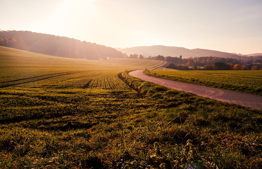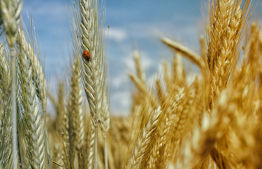Parashat Kedoshim: Neta Revay and Aqraba

Chazal instituted that those living within a day's walking distance to Jerusalem bring up neta revay fruit to the Beit Hamikdash, and state the borders of this radius. A visit to Akrabat, the northernmost border, and its halachic and historical significance.
Aqrabat of kerem revay
"In the fourth year all its fruit shall be set aside for jubilation before the L-rd" (Levit. 19:24).
"Kerem revay was brought to Jerusalem from a radius of a day-long journey. And what is its boundary? From Eilat in the south and Aqrabat in the north. From Lod in the west and the Jordan river in the east. And when the produce increased, they decreed that it could be redeemed even up to the wall. And the matter was conditional—that whenever they wanted, the matter would revert to how it was originally. Rabbi Yosi says: This condition was made when the Temple was destroyed, and the condition was that whenever the Temple would be rebuilt, the matter would revert to how it was originally" (Mishna Ma'aser Sheni 5:2).
Bringing neta revay up to Jerusalem vs. redeeming it
Our parasha teaches us about the mitzvah of neta revay in the fourth year following three years of orlah. The fruit of the fourth year are to be treated like that of ma'aser sheni, which are to be brought up to Jerusalem and eaten in a state of ritual purity. Alternatively, it was possible to transfer their sanctity to a coin worth the value of the fruit (plus a chomesh, which came out to an additional quarter of its value), and then use the money to purchase food in Jerusalem. The food purchased in Jerusalem with this sacred money would be eaten in a state of ritual purity. So that the markets of Jerusalem would be decked out by many fruits, our Sages instituted that anyone who lived up to a one-day's journey from Jerusalem needed to bring the fruit there, and not redeem it. This condition was in place (according to Rabbi Yosi) until the Temple's destruction. After the destruction, when pilgrimages were no longer made to the Temple, there was no longer any reason to fill the Jerusalem markets with fruit. For this reason, the Sages permitted redeeming all neta revay fruit, even from areas close to the wall encircling Jerusalem. However, even after the Temple, once fruit is brought into the sacred area of Jerusalem (such as the Old City), it is no longer possible to redeem the fruit.
Today we transfer the sanctity of this fruit, plus a chomesh, onto one peruta (the value of a peruta is 1/40th of a gram of sterling silver; about 2 cents as of Nissan 5779), regardless of the value of the fruit. This is because we cannot eat ma'aser sheni or neta revay today in a state of ritual purity. Even during Temple times, bedi'avad, it was possible to redeem neta revay fruit onto a coin that was not equivalent to the fruits' true value. Ever since the Temple's destruction, we do so lechatchila.
During Temple times, requirement to bring up the actual fruit without redemption still applied, the Sages did not make do with a general definition of a "one day's journey from Jerusalem." Rather, they named four places that marked the outer limits of this area. This time we will take a look at the northernmost boundary: Akrabat or Aqraba.
Aqraba: an ir ma'amad
This city, identified with the modern Arab town Aqraba, which preserved its name, is southeast of Shechem (approximately 40 km from Jerusalem; from here we know that people in ancient times would and could cover 40 km on foot in one day!). Aqraba was part of Judea, and was positioned on the border of the area formerly inhabited by Samaritans (Kutim), and it overlooks the hillside towards the Jordan Valley. During the time of the Great Rebellion, the Jews launched an attack on the Samaritans from Aqraba. From the description of Josephus Flavious, it seems that this town was one of eleven (or perhaps a few more) of the counties of Judea. If this was true, this had added significance for other mitzvot tied to the Land of Israel. The Mishna in tractate Bikurim (3:2) states that pilgrims bringing bikurim to the Temple came as groups, not as individuals. All of the towns in a certain area would first go to a major city, called by the Mishna an ir ma'amad. Ben-Zion Segal notes that according to the Tosefta (Bikurim 2:8), an ir ma'amad was a county. Since Aqrabat was a county, this means it also was one of the arei ma'amad where bikurim bearers would come together to begin their pilgrimage to the Temple.
Remains from the Second Temple era were discovered in Aqraba: ruins of buildings and burial caves. However, due to later construction, findings from this period are relatively scarce. Not far from Aqraba is khirbet (Tel) al-Arama, identified by Hanan Eshel and Ze'ev Ehrlich as the ancient fortress of Aqraba county. Onsite are several large reservoirs, in use during the Hasmonean period. This helps shed light on the site's important role, and of the Aqraba county as a whole, on the Judean border, facing the Samaritan stronghold. This area is also identified with a city dating back to the period of the Shoftim: Aruma, the capital city of Avimelech ben Gidon (9:41).




